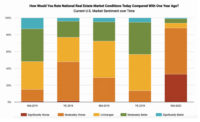
The comeback of the commercial mortgage-backed securities sector, which reached a high of $230 billion in new issues in 2007 but then collapsed in the turmoil that hit financial markets in 2008, has run into big trouble.
"There are economic headwinds that are causing a slowdown in the pipeline,” says Steve Renna, chief executive officer of the Commercial Real Estate Finance Council, New York City.
The latest slowdown hit in July, when Standard & Poor's sent markets into a roil after it declined to rate a $1.5-billion commercial-mortgage bond that had already been placed with investors. S&P said there was a discrepancy in the way it graded the transactions.
Howard Eski, global head of structured finance research for S&P, wouldn't comment directly on the action (S&P, like ENR, is a unit of The McGraw-Hill Cos.) Eski says the CMBS slowdown is because of the uncertainty and volatility in the markets. “People are retrenching everywhere,” he says.
Uncertainty has been the watchword in major markets for the past year, especially with European Union countries such as Greece struggling to contain debt crises, followed by S&P's bombshell announcement in early August that it had downgraded the AAA rating of United States debt one notch to AA+., a first for the U.S.
Now, fears about sluggish growth prospects for the U.S. and Europe have apparently tripped up the nascent recovery of mortgage-backed securities.
Mortgage-backed securities help owners finance malls, office buildings and hotels. Although they don't provide direct financing for new construction, the securities do provide liquidity to companies that own the buildings. At the CMBS market's peak in 2007, construction in related market segments also boomed.
After the market collapse in 2008, the CMBS industry revised its practices to inject more transparency in the CMBS markets and improve underwriting standards. The revisions, called CMBS 2.0, are designed to give investors more confidence in the the CMBS market. Between those revisions, and the general uptick in the economy, some speculated that CMBS sales could go as high as $50 billion this year, though Renna said a more realistic forecast was closer to $35 billion.
New CMBS issues reached about $11 billion last year.
Earlier this year, Standard & Poor's commented that there were more originators of CMBS loans, and that the loan pool was growing. It noted in a report on CMBS that commercial real estate transaction volume more than doubled from 2009 to 2010. Lower yields on many notes signaled lower default risks in the loan pools.




Post a comment to this article
Report Abusive Comment